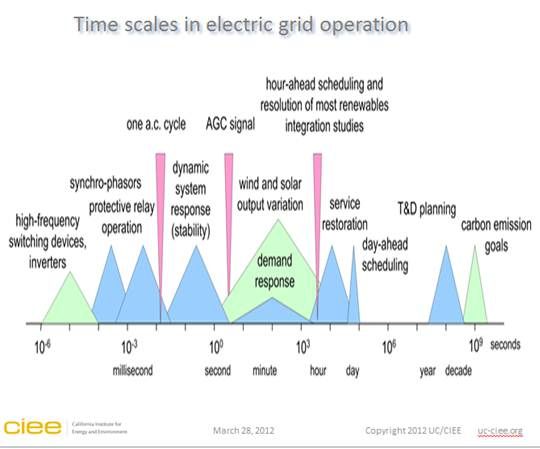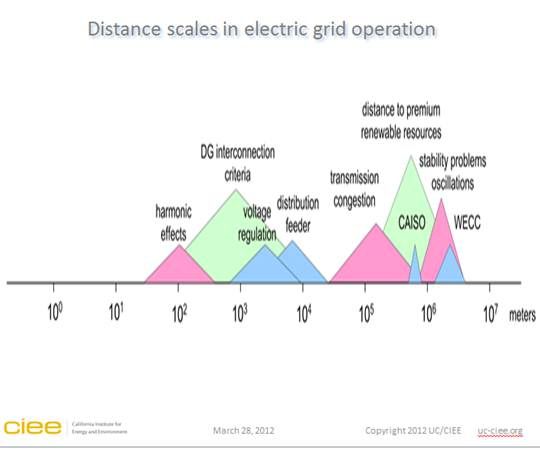[Editor’s Note: Some more provocative thoughts in GTM’s intermittent series on grid integration of variable renewables.]
As more renewables and tools to integrate them into the transmission and distribution system become available to grid system operators, a new set of challenges is emerging.
Alexandra von Meier, a UC Berkeley energy researcher, has developed a new framework with which those challenges can be better understood.
“When you are integrating renewables, until now, when people asked the question, ‘Can we have 100 percent renewables?' usually that was taken to mean, ‘Is there enough resource to fill all 8,760 hours of the year? And, if not, how much storage do we need?’” explained von Meier, the Co-Director of Electric Grid Research at UC Berkeley’s California Institute for Energy and Environment. “That level of analysis is no longer where the most difficult problems are.”
Speaking at last month’s UCLA Smart Grid Thought Leadership Forum, von Meier described “a conceptual map to situate these different problems” along “time and distance scales” that trace the new transmission system environment created by the increasing amounts of power that today’s grid operators are getting from renewables.
“The question of ‘Can we figure out enough sources to fill this?’ was done with a one-hour resolution,” von Meier said. But what about the challenges presented by, for instance, the changing supply of solar energy as clouds move across a sunny sky? Those are represented on von Meier’s time scale “when you move toward the left from the one-hour spot to say ‘Can we manage the minute-to-minute fluctuations?’”
A grid operator whose forecast predicts a drop in solar energy availability an hour ahead of time, von Meier explained, “can get on the phone and say, ‘Alright, we need to fire up this gas plant to kick in at 3 p.m.’ But when you have a sudden drop and then a sudden increase of power, that happens over the course of fifteen seconds, and it requires a different kind of technology to absorb those fluctuations. And it is in that area that we have unknown unknowns. We are not sure how difficult this is going to get as we install more and more solar and wind.”
In the past, von Meier said, the challenge “was the power and the flow rate of energy. Now we are moving to the next level of being worried not just about power but the rate at which power changes.” It is the ramp rate of power, she pointed out, that is important to today’s grid operators.
“There is a solution,” von Meier said, “but it’s pricey,” because it “requires different management schemes and technologies.”

Von Meier’s time scale presents one dimension of the challenge. There is also a distance scale. She described a type of “oscillations” in transmission “that go across hundreds or even a thousand miles. From Canada or Wyoming down to Southern California -- that’s over a thousand miles.”

Delivering renewables means, first, confronting the challenge of building a transmission and distribution system to reach remote solar and wind resources. “But even if you can build a line that goes there, you still may be exacerbating the oscillation problem,” von Meier said. “Again, there is a solution, but it’s pricey,” she added. “DC lines eliminate it -- and they cost a lot of money.”
Von Meier declined to discuss the specific cost. “It is very difficult to make estimates because there are so many assumptions and you could easily be off by a factor of three in your estimate.”
But there are two important parts to the accurate assessment of the costs of integrating renewables on the grid, von Meier said.
“If you make the investment, you will also be able to recover more benefits from the distributed generation. It might have a hidden cost but it also has hidden benefits.”
And, she said, “it requires an intelligent infrastructure to draw on the benefit provided from the distributed generation. If you are connecting it stupidly, it might cause problems. To avoid the problems, you have to connect it smartly. That costs money. But by connecting it smartly, you are now able to leverage services from it that you didn’t know you could get.”
The second part of the assessment, she explained, “is that some of these upgrades, we might have to make eventually, regardless.”
The transmission and distribution system is “very rapidly aging” and “the need for upgrading this infrastructure has grown faster than we have invested in it.”
To accurately assess the cost of renewables integration, von Meier said, “what you really have to ask is not how much it costs to upgrade the infrastructure to accommodate the renewables, but how much more does it cost compared to what you were going to have spend anyway to keep the lights on?”



